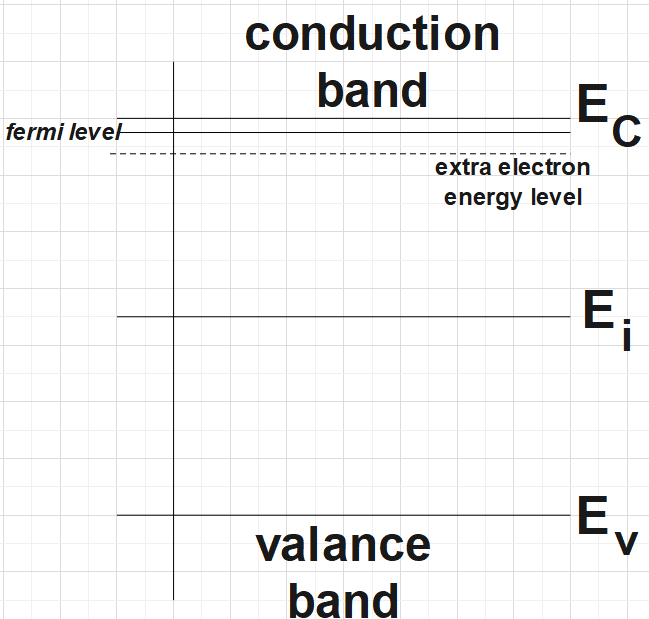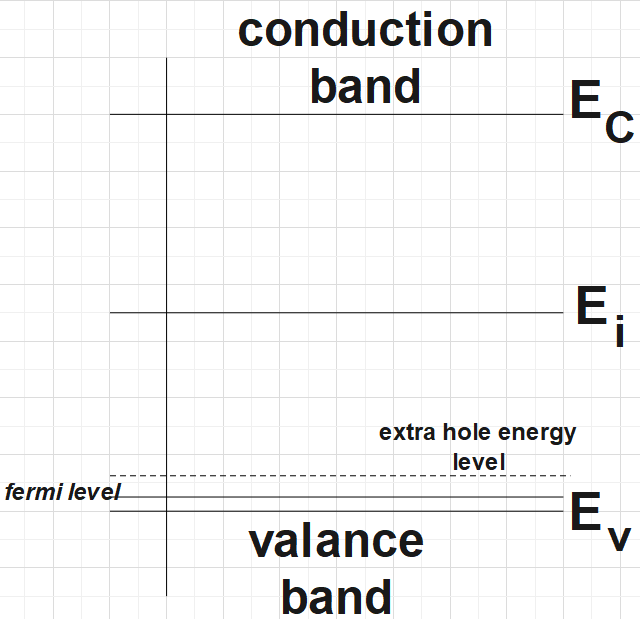
Answer
388.8k+ views
Hint: As a first step, one could recall the theory that they had learnt about the mentioned semiconductors. Then you could use the same to make the energy band diagram for both. After that recall the law of mass action and then substitute accordingly to solve the second part of the question.
Formula used:
Law of mass action,
$np={{n}_{i}}^{2}$
Complete answer:
Firstly, we are asked to draw the energy band diagrams for the n-type and p-type semiconductor at some temperature less than 0. Following are the diagrams where we have clearly marked the donor and acceptor levels, fermi level, etc.
For the n-type semiconductor the energy diagram would look like as:

Now, for the p-type semiconductor the energy band diagram would look something like this:

Now, let us look at the second part of the question which is a numerical problem. In order to solve this problem let us recall the law of mass action given by,
$np={{n}_{i}}^{2}$
Here we are given the intrinsic carrier concentration as,
${{n}_{i}}=6\times {{10}^{8}}{{m}^{-3}}$
Now, we are given the increased level of electron as,
$n=9\times {{10}^{12}}{{m}^{-3}}$
Now, we could substitute these values into the law of mass action to get,
$p=\dfrac{{{\left( 6\times {{10}^{8}} \right)}^{2}}}{9\times {{10}^{12}}}$
$\therefore p=4\times {{10}^{4}}{{m}^{-3}}$
Therefore, the new hole concentration to be $p=4\times {{10}^{4}}{{m}^{-3}}$.
Note:
While making the diagram one should take care that they don’t miss out any of the energy level. You could recall your basic understanding of the given semiconductors, namely, the n-type and the p-type. So, you would get the basic idea as to where acceptor level and donor level are significant.
Formula used:
Law of mass action,
$np={{n}_{i}}^{2}$
Complete answer:
Firstly, we are asked to draw the energy band diagrams for the n-type and p-type semiconductor at some temperature less than 0. Following are the diagrams where we have clearly marked the donor and acceptor levels, fermi level, etc.
For the n-type semiconductor the energy diagram would look like as:

Now, for the p-type semiconductor the energy band diagram would look something like this:

Now, let us look at the second part of the question which is a numerical problem. In order to solve this problem let us recall the law of mass action given by,
$np={{n}_{i}}^{2}$
Here we are given the intrinsic carrier concentration as,
${{n}_{i}}=6\times {{10}^{8}}{{m}^{-3}}$
Now, we are given the increased level of electron as,
$n=9\times {{10}^{12}}{{m}^{-3}}$
Now, we could substitute these values into the law of mass action to get,
$p=\dfrac{{{\left( 6\times {{10}^{8}} \right)}^{2}}}{9\times {{10}^{12}}}$
$\therefore p=4\times {{10}^{4}}{{m}^{-3}}$
Therefore, the new hole concentration to be $p=4\times {{10}^{4}}{{m}^{-3}}$.
Note:
While making the diagram one should take care that they don’t miss out any of the energy level. You could recall your basic understanding of the given semiconductors, namely, the n-type and the p-type. So, you would get the basic idea as to where acceptor level and donor level are significant.
Recently Updated Pages
what is the correct chronological order of the following class 10 social science CBSE

Which of the following was not the actual cause for class 10 social science CBSE

Which of the following statements is not correct A class 10 social science CBSE

Which of the following leaders was not present in the class 10 social science CBSE

Garampani Sanctuary is located at A Diphu Assam B Gangtok class 10 social science CBSE

Which one of the following places is not covered by class 10 social science CBSE

Trending doubts
Which are the Top 10 Largest Countries of the World?

Fill the blanks with the suitable prepositions 1 The class 9 english CBSE

How do you graph the function fx 4x class 9 maths CBSE

In Indian rupees 1 trillion is equal to how many c class 8 maths CBSE

The Equation xxx + 2 is Satisfied when x is Equal to Class 10 Maths

Give 10 examples for herbs , shrubs , climbers , creepers

Why is there a time difference of about 5 hours between class 10 social science CBSE

Difference between Prokaryotic cell and Eukaryotic class 11 biology CBSE

What is BLO What is the full form of BLO class 8 social science CBSE



